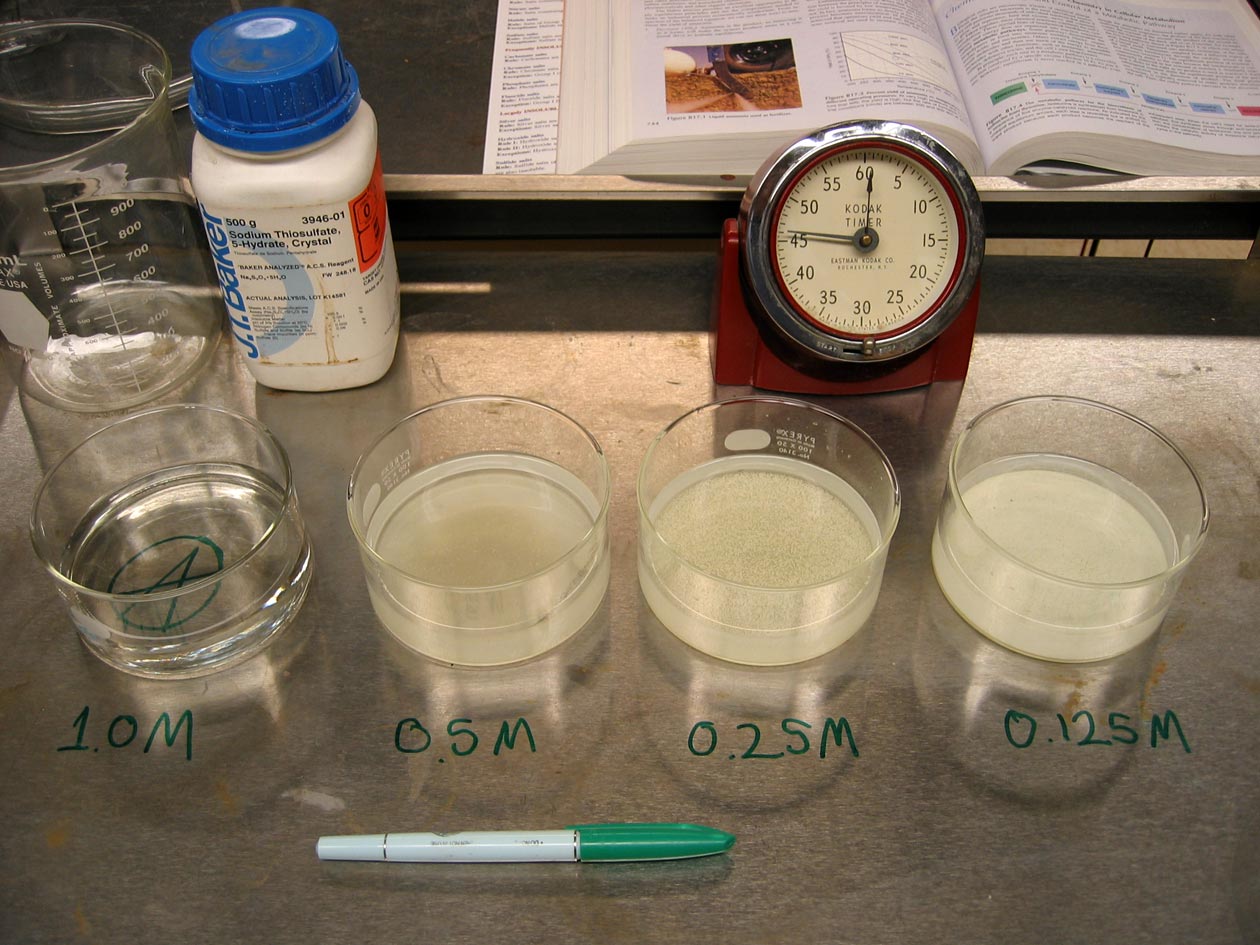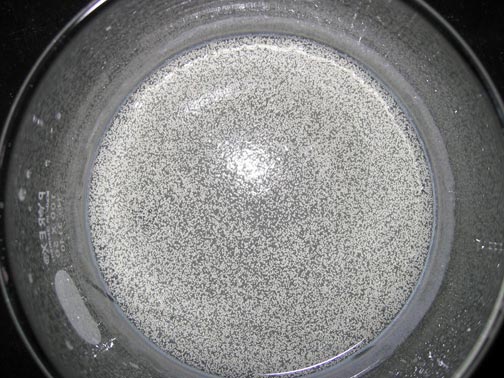Experimental determination of the orders of reaction by varying concentration
 A reaction of clear and colorless solutions of acid and sodium thiosulfate generates an opaque product of colloidal sulfur.
A reaction of clear and colorless solutions of acid and sodium thiosulfate generates an opaque product of colloidal sulfur.
Ingredients: sodium thiosulfate, hydrochloric acid
Procedure: A complete recipe follows.
1. Prepare solutions of sodium thiosulfate with concentrations 0.125, 0.25, 0.50, and 1.0M.
2. Place reaction vessel containing clear and colorless thiosulfate solution atop an image.
3. Add fixed amount of 5.0M solution of hydrochloric acid.
4. At the moment that the acid is added, begin to measure the total time of reaction.
5. Observe the creation of opaque colloidal sulfur.
6. The reaction is considered "complete" when the solution is opaque and the image below the vessel is no longer visible.
7. Repeat the process for the remaining concentrations of thiosulfate and record the reaction times for all.
Understanding: Sodium thiosulfate reacts spontaneously with acid to produce colloidal sulfur
S2O32-(aq) → S(s) + SO32-(aq)
What sort of reaction is this? It is clearly a redox reaction. It is a special type of redox reaction known as a disproportionation reaction where the single reactant is both oxidized and reduced. The two sulfur atoms start with a positive oxidation state of +2. One of the sulfur atoms is reduced to colloidal atomic sulfur, with an oxidation state of 0. The remaining sulfur atom assumes an oxidation state of +4 in the sulfite ion.We can balance the reduction half-reaction as
6 H+(aq) + 4 e- + S2O32-(aq) → 2 S(s) + 3 H2O(l)
and the oxidation half-reaction as3 H2O(l) + S2O32-(aq) → 2 SO32-(aq) + 6 H+(aq) + 4 e-
The overall reaction isS2O32-(aq) → S(s) + SO32-(aq)
The hydrogen ion is neither a reactant or product in the overall reaction as written. It appears that the overall reaction will be the same in acidic or basic solution.Knowing that the chemical reactants are sodium thiosulfate and hydrochloric acid, we can write the simple reaction rate formula as
rate of reaction = k [S2O32-]n [H+]m
The powers of the concentrations, n and m, are known as the orders of reaction. We say that the reaction rate is "nth order in thiosulfate concentration, and mth order in hydrogen ion concentration." And so on. k is the rate constant, a proportionality constant relating the rate of reaction to the reactant and product concentrations.Using a bit of calculus, we can express the rate of reaction in terms of the rate of change in the concentration of the thiosulfate ion
rate of reaction = - (1/n) d[S2O3-2]/dt = k [S2O32-]n [H+]m
The rate of reaction is always positive. As the rate of change in the thiosulfate ion is negative, the derivative is multiplied by -1.It is straightforward to experimentally determine the order of reaction with respect to the thiosulfate concentration. We can simply vary the concentration of the thiosulfate in solution, and measure how the rate of reaction changes!
If we double the thiosulfate ion concentration, and the rate of reaction is unchanged, the reaction is zeroth order in thiosulfate ion concentration. If we double the thiosulfate ion concentration, and the rate of reaction doubles, the reaction is first order with respect to thiosulfate ion concentration. If we double the thiosulfate ion concentration, and the rate of reaction quadruples, the reaction is second order with respect to the thiosulfate ion concentration. And if we quadruple the thiosulfate ion concentration, and the rate of reaction increases by a factor of two, the reaction is one-half order with respect to thiosulfate ion concentration. Yes, fractional orders of reaction are possible!
It was observed that by varying the concentration of thiosulfate ion from 1.0M to 0.5 M to 0.25 M to 0.125 M, the reaction times were 7, 14, 28, and 56 seconds, respectively. What is the order of reaction with respect to the thiosulfate ion? We first observe that the rate of reaction is inversely proportional to the reaction time. Therefore, if we have the reaction times of 7, 14, 28, and 56 s, we might say that the corresponding reaction rates are given by
reaction rate = 1/(reaction time)
1/7, 1/14, 1/28, and 1/56 s-1. If we take the smallest reaction rate, 1/56 s-1, and divide it into each reaction rate, we find the corresponding ratio of reaction rates 8:4:2:1.
When the concentration of thiosulfate ion is doubled from 0.5M to 1.0M, the reaction rate doubles. When the concentration of thiosulfate ion is increased by a factor of eight from 0.125M to 1.0M, the reaction rate increases by a factor of eight. It follows that the reaction is first order in thiosulfate ion concentration.
As the reaction proceeds, a colloidal suspension of sulfur is formed. Shining a laser pointer through the solution, the beam of the laser pointer will be apparent to the eye. The light of the laser is scattered by the small colloidal particles of sulfur, even before the particles are apparent to the eye in higher concentrations. This is precisely what happens when the beam of a car's headlights become visible in a fog. The scattering of light by a colloid is known as the Tyndall effect.
 A colloid consists of small deposits of one substance that are dispersed in another. For example, fog is a colloid, with small droplets of water dispersed in air. Milk is a colloid, with small droplets of fat dispersed in water. A wide-range of colloids are possible. The dispersed phase can be gas, liquid or solid, and the dispersing phase can be gas, liquid, or solid. All combinations of dispersed phase and dispersing phase have been observed. Colloids form a wide variety of substances that we encounter, including emulsions, foams, sols, gels, and aerosols. Colloids are everywhere!
A colloid consists of small deposits of one substance that are dispersed in another. For example, fog is a colloid, with small droplets of water dispersed in air. Milk is a colloid, with small droplets of fat dispersed in water. A wide-range of colloids are possible. The dispersed phase can be gas, liquid or solid, and the dispersing phase can be gas, liquid, or solid. All combinations of dispersed phase and dispersing phase have been observed. Colloids form a wide variety of substances that we encounter, including emulsions, foams, sols, gels, and aerosols. Colloids are everywhere!
There are many applications of colloids in food, science, industry, and the arts. A well known use of colloids in biology is the use of colloidal silver to enhance the immune system. In ancient times, it was noted that storing liquids in silver vessels, or adding a silver coin to a vessel containing liquid, could protect the liquid against bacterial growth. Such observations led to the use of colloidal silver as an antibiotic. Some individuals even take colloidal silver on a regular basis, as a preventive medication. However, others note that silver consumption can lead to the greying of the skin due to the deposition of silver. The topic remains controversial.
The formation of colloidal sulfur and the point of equilibrium
Question: The point of equilibrium in this reaction can be influenced by the concentration of acid. As the concentration of acid is increased, more sulfur product is formed. However, the balanced equation for the reactionS2O32-(aq) → S(s) + SO32-(aq)
shows no dependence on [H+]. Explain this effect using your knowledge of chemistry and Le Chatelier's Principle.You can check your answers here.